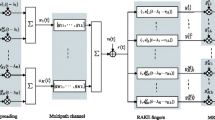Abstract
This paper is to present a systematic performance analysis of asynchronous quaternary direct sequence code division multiple access (DS-CDMA) systems using random signature sequences with arbitrary chip waveforms. The simplified improved Gaussian approximation method for bit error rate computation is extended to include arbitrary time-limited (full response or partial response) or band-limited chip waveforms with arbitrary receiver filters. As a time-limited partial response chip waveform modulation format, the well-known power and spectral efficient “superposed quadrature amplitude modulation” with matched filter or zero-forcing filter is evaluated, and the results show that the optimum zero-forcing filter will yield a performance better than the matched filter counterpart. For band-limited chip waveforms, based on an elementary density function of a second-order polynomial, a class of second-order continuity pulses is proposed for analysis. It is found that all common band-limited pulses are only its special cases. As a member of the class, the widely used frequency domain raised cosine pulse has the worst anti-multiuser-access-interference capability, which has been pointed out in (H. H. Nguyen, Proceedings of IEEE Canadian Conference on Electrical & Computer Engineering, 2002, pp. 1271–1275).
Similar content being viewed by others
References
F.D. Garber and M.B. Pursley, “Performance of Offset Quadriphase Spread-Spectrum Multiple-Access Communications”, IEEE Transaction Communication, Vol. 29, pp. 305–314, March 1981.
E.Geraniotis and B.Ghaffari, “Performance of Binary and Quaternary Direct-Sequence Spread-Spectrum Multiple-Access Systems with Random Signature Sequences”, IEEE Transactions on Communication, Vol.39, pp. 713–724, May 1991.
M.A. Landolsi and W.E. Stark, “DS-CDMA Chip Waveform Design for Minimal Interference Under Bandwidth, Phase, and Envelope Constraints”, IEEE Transaction Communication, Vol. 47, pp. 1737–1746, November 1999.
J.H. Cho and J.S. Lehnert, “An Optimal Signal Design for Band-Limited Asynchronous DS-CDMA Communications”, IEEE Transactions on Information Theory, Vol. 48, pp. 1172–1185, May 2002.
W. Gao, J.H. Cho and J.S. Lehnert, “Chip Waveform Design for DS/SSMA Systems with Aperiodic Random Spreading Sequences”, IEEE Transanctions on Wireless Communication, Vol.1, pp. 37–45, January 2002.
H.H. Nguyen, “A Study of Band-Limited Chip Waveforms for Asynchronous DS-CDMA Systems”, in Proceedings of IEEE Canadian Conference on Electrical @ Computer Engineering, 2002, pp. 1271–1275.
H.H. Nguyen and E. Shwedyk, “On Error Probability of DS-CDMA Systems with Arbitrary Chip Waveforms”, IEEE Communication Letters, Vol.5 pp. 78–80, March 2001.
T.F. Wong, T.M. Lok and J.S. Lehnert, “Asynchronous Multiple-Access Interference Suppression and Chip Waveform Selection with Aperiodic Random Sequences”, IEEE Transactions on Commununication, Vol. 47, pp. 103–114, January 1999.
P.I. Dallas and F.N. Pavlidou, “Innovative Chip Waveforms in Microcellular DS/CDMA Packet Mobile Radio”, IEEE Transanctions on Commununication, Vol. 44, pp. 1413–1416, November 1996.
R. Anjaria and R. Wyrwas, “The Effect of Chip Waveform on the Performance of CDMA Systems in Multipath, Fading, Noisy Channels”, in Proceedings of 42nd VTS Conference, Denver, 1992, pp. 672–675.
T.Luo, S. Pasupathy and E.S. Sousa, “Interference Control and Chip Waveform Design in Multirate DS-CDMA Communications Systems”, IEEE Transactions on Wireless Communication, Vol. 1, pp. 56–66, January 2002.
J.H. Cho and J.S. Lehnert, “System Design for DS/SSMA Communications with Negative Chip Excess Bandwidth”, in Proceedings of Military Communication Conference, 2001, pp. 1050–1054.
T. Ojanpera and R. Prasad, “An Overview of Air Interface Multiple Access for IMT-2000/UMTS”, IEEE Communication Magazine, Vol. 36, pp. 82–95, September 1998.
Y. Asano, Y. Daido and J. M. Holtzman, “Performance Evaluation for Band-Limited DS-CDMA Communication System”, in Proceedings of IEEE Vehecular Technology Conference, Secaucus, NJ, May 18–20, 1993, pp. 464–468.
R.K. Morrow, “Accurate CDMA BER Calculations with Low Computational Complexity”, IEEE Transanctions on Communication, Vol. 46, pp. 1413–1417, November 1998.
J.M. Holtzman, “A Simple, Accurate Method to Calculate Spread-Spectrum Multi-Access Error Probabilities” IEEE Transanctions on Communication, Vol. 40, pp. 461–464, March 1992.
Y.C. Yoon, “A Simple and Accurate Method of Probability of Bit Error Analysis for Asynchronous Band-Limited DS-CDMA Systems”, IEEE Transanctions on Communication, Vol. 50, pp. 656–663, April 2002.
J. Seo and K. Feher, “SQAM: A New Superposed QAM Modem Technique”, IEEE Transanctions on Communication, Vol. 33, pp. 296–300, March 1985.
G.L. Stuber, Principles of Mobile Communication, Second Edition. Kluwer Academic Publisher, 2001.
O. Andrisano and M. Chiani, “The First Nyquist Criterion Applied To Coherent Receiver Design for Generalized MSK Signals”, IEEE Transanctions on Communication, Vol. 42, pp. 449–457, April 1994.
M. Luise and U. Mengali, “A New Interpretation of the Average Matched Filter for MSK-Type Receivers”, IEEE Transanctions on Communication, Vol. 39, pp. 14–16, January 1991.
H. Nyquist, “Certain Topics in Telegraph Transmission Theory”, Transanctions of the AIEE, Vol. 47, pp. 617–644, Feberuary 1928.
N.C. Beaulieu, C.C. Tan, and M.O. Damen, “A “better than” Nyquist Pulse”, IEEE Communication Letters, Vol. 5, pp. 367–368, September 2001.
F. Amoroso, “Pulse and Spectrum Manipulation in the Minimum (frequency) Shift Keying (MSK) Format”, IEEE Transanctions on Communication, Vol. 24, pp. 381–384, March 1976.
J.P. Chaib and H. Leib, “Chip Shaping and Channel Coding for CDMA”, Eurupean Transactions on Telecommunication, Vol. 7, pp. 133–143, March–April 1996.
R.K. Morrow and J.S. Lehnert, “Bit-to-Bit Error Dependence in Slotted DS/CDMA Packet Systems with Random Signature Sequences”, IEEE Transanctions on Communication, Vol. 37, pp. 1052–1061, October 1989.
G. Zhang and C. Ling, “Performance Evaluation for Band-Limited DS-CDMA Systems Based on Simplified Improved Gaussian Approximation”, IEEE Transactions on Communication, Vol. 51, pp. 1204–1213, July 2003.
Author information
Authors and Affiliations
Corresponding author
Rights and permissions
About this article
Cite this article
Song, R., Leung, S. A Unified Analysis of Quaternary DS-CDMA Systems with Arbitrary Chip Waveforms and Its Applications. Wireless Pers Commun 31, 111–129 (2004). https://doi.org/10.1007/s11277-004-7634-9
Issue Date:
DOI: https://doi.org/10.1007/s11277-004-7634-9




